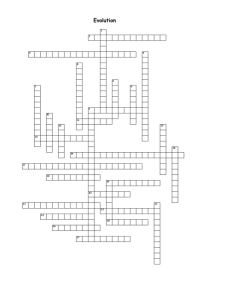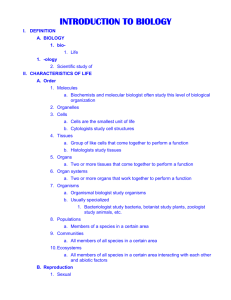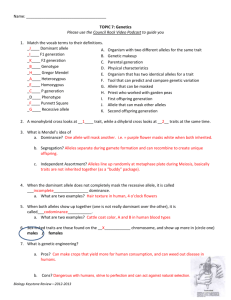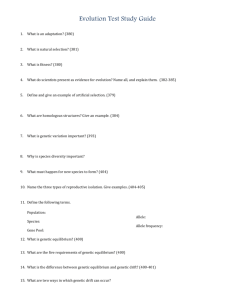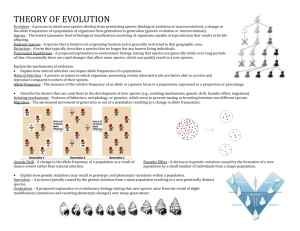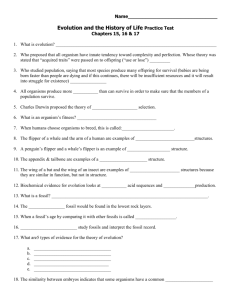Module 2: Theory of Evolution
advertisement
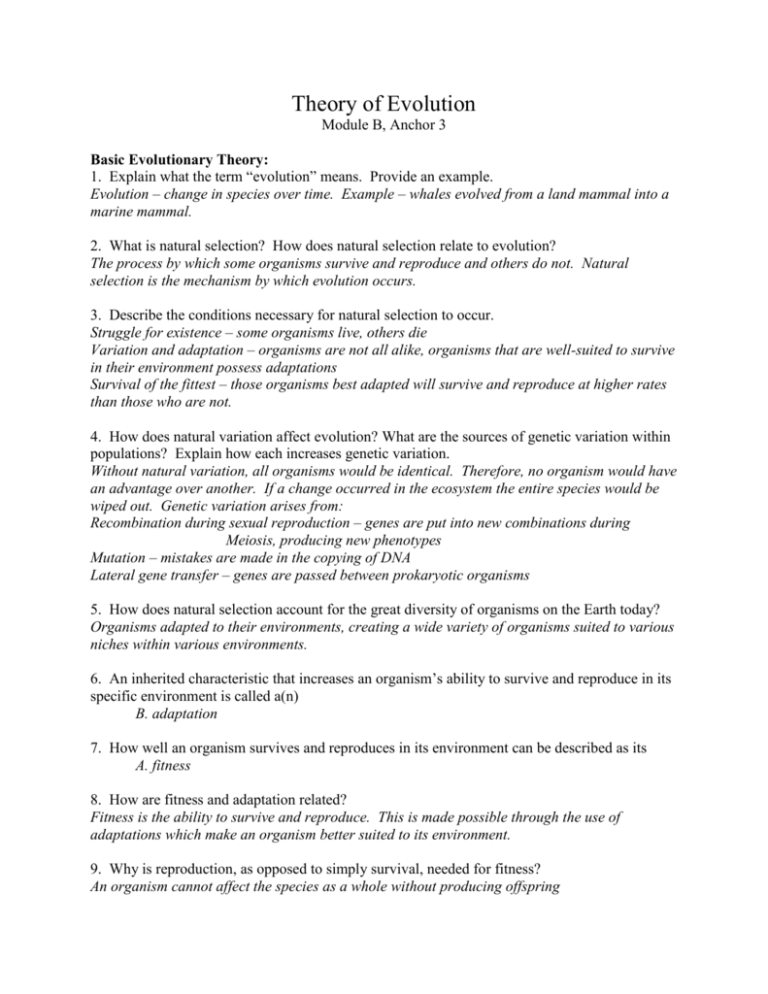
Theory of Evolution Module B, Anchor 3 Basic Evolutionary Theory: 1. Explain what the term “evolution” means. Provide an example. Evolution – change in species over time. Example – whales evolved from a land mammal into a marine mammal. 2. What is natural selection? How does natural selection relate to evolution? The process by which some organisms survive and reproduce and others do not. Natural selection is the mechanism by which evolution occurs. 3. Describe the conditions necessary for natural selection to occur. Struggle for existence – some organisms live, others die Variation and adaptation – organisms are not all alike, organisms that are well-suited to survive in their environment possess adaptations Survival of the fittest – those organisms best adapted will survive and reproduce at higher rates than those who are not. 4. How does natural variation affect evolution? What are the sources of genetic variation within populations? Explain how each increases genetic variation. Without natural variation, all organisms would be identical. Therefore, no organism would have an advantage over another. If a change occurred in the ecosystem the entire species would be wiped out. Genetic variation arises from: Recombination during sexual reproduction – genes are put into new combinations during Meiosis, producing new phenotypes Mutation – mistakes are made in the copying of DNA Lateral gene transfer – genes are passed between prokaryotic organisms 5. How does natural selection account for the great diversity of organisms on the Earth today? Organisms adapted to their environments, creating a wide variety of organisms suited to various niches within various environments. 6. An inherited characteristic that increases an organism’s ability to survive and reproduce in its specific environment is called a(n) B. adaptation 7. How well an organism survives and reproduces in its environment can be described as its A. fitness 8. How are fitness and adaptation related? Fitness is the ability to survive and reproduce. This is made possible through the use of adaptations which make an organism better suited to its environment. 9. Why is reproduction, as opposed to simply survival, needed for fitness? An organism cannot affect the species as a whole without producing offspring 10. What is the role of the environment in determining fitness? The environment determines what traits make an organism more fit. For example, a trait allowing organisms to store water would increase fitness in a desert environment. In a rainforest, this trait would not be advantageous. 11. Why does natural selection work only on heritable characteristics, as opposed to acquired characteristics? Acquired characteristics cannot be passed on to offspring, therefore they cannot affect the genetic make-up of the population. For example, dying your hair purple does not give you genes for purple hair. Therefore, your children will not have purple hair. 12. What is the principle of common descent? All life is descended from one common ancestor. 13. Use the theory of natural selection to explain how two unrelated organisms, such as sharks and dolphins, come to possess very similar physical adaptations. The organisms occupy similar niches in similar environments. Therefore, the same types of adaptations are advantageous to them. This would lead to the possession of very similar physical traits. Natural Selection and Genetics: 1. The combined genetic information of all members of a particular population forms a: A. gene pool 2. How is evolution defined, genetically speaking? Change in allele frequency. 3. Explain what the term relative frequency means, include an example illustrating your answer. The frequency of an allele in relation to the other alleles in the gene pool. For example, fur color in rabbits comes in grey and white. There are 65 grey alleles and 35 white alleles. The frequency of the grey allele is .65; the frequency of the white allele is .35. How does evolution change the relative frequency of alleles in a gene pool? Why does this happen? Natural selection selects against particular phenotypes. The frequency of the alleles controlling those phenotypes is decreased. The frequency of other alleles in the gene pool goes up in response. 4. The frequency of a particular allele changes from 30% to 10%. Is this population evolving? Why or why not? Yes. The allele frequency has changed significantly. 5. Does natural selection work directly or indirectly on genotype? Explain your answer. Phenotype. An albino rabbit dies because it is white and stands out to predators more than a brown rabbit. It does not die because it has a white allele. 6. Compare and contrast evolution in single-gene vs. polygenic traits. Single gene traits – measured by change in allele frequency Polygenic – measured by shift in phenotypes, as the genetics behind various phenotypes are extremely complicated. 7. List and describe the three types of selection which occur when polygenic traits are evolving. Directional – organisms on either end of the bell curve become more fit, shifting the average to one side or the other Stabilizing – organisms at either end of the curve become less fit, exaggerating the already existing norm. Disruptive – organisms at both ends of the curve become more fit, creating two distinct phenotypes. 8. What is genetic drift? List and describe the two types of genetic drift. Allele frequencies change by chance, as opposed to natural selection. Founder effect – a small group of organisms colonizes a new habitat. By chance, there genetic make-up is different than the original population as a whole Bottleneck effect – the population is quickly and dramatically reduced. The surviving organisms have a different allele frequency than the original population. 9. Compare and contrast genetic drift and natural selection. Both result in changes to allele frequencies, but natural selection is not due to chance. 10. What is genetic equilibrium? The allele frequencies within a population remain stable. 11. What are the conditions required in order to maintain genetic equilibrium? Explain each. Large population – reduces effect of genetic drift No mutation – does not introduce new alleles into the population Random mating – no particular group is leaving more offspring No movement in or out of the population – individuals arriving may bring new alleles, individuals leaving may remove alleles No natural selection – natural selection changes allele frequencies do to variations in fitness. 12. Which of the following conditions is MOST likely to result in changes in allele frequencies in a population? B. small population size Speciation: 1. What constitutes a species? Individuals who can mate and create fertile offspring. 2. What is necessary for speciation to occur? Why is this necessary? Reproductive isolation – allows differences in the genetics of a population to build up until they can no longer produce fertile offspring. 3. List and describe the types of reproductive isolation. Geographic – populations are separated by a physical barrier Behavioral – populations are physically able to mate, but do not due to behavioral issues (ex – different courtship rituals) Temporal – populations mate at different times (one in April, one in June) Mechanical – reproductive organs do not fit correctly 4. Can two populations be separated by more than one isolating mechanism? Yes 5. Describe the genetic changes which occur between populations after reproductive isolation has occurred. As the individuals mate, changes occur to their genetic material. Since they are not reproducing together, these differences do not become shared in their offspring. This makes them less and less similar. Evidence for Evolution: 1. Explain how each of the following provide evidence for evolution: Vestigial structures – Structures which once had a function, but no longer do. They would not be present unless they were once used. Homologous structures – same structure, different function. Ex – wing of bat, flipper of whale, arm of human. Would not be structurally similar if they didn’t have a common ancestor. Analogous structures – Unrelated organisms with similar physical structures. Show how organisms adapt to their environment. Biogeography – Organisms that are unrelated but live in similar environments have similar adaptations due to their similar needs Fossils – Provide a visual record of how organisms change over time Embryology – Vertebrate embryos look very similar in the womb, possessing traits their adult counterparts lack. They would not have these parts if they did not once use them. Molecular biology – The number of differences in an amino acid sequence can be calculated to determine how long ago the organism shared a common ancestor. 2. If species A and B have very similar genes and proteins, what is probably true? A. Species A and B share a relatively recent common ancestor

